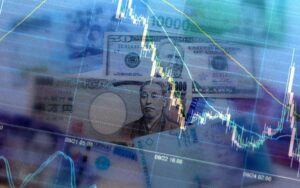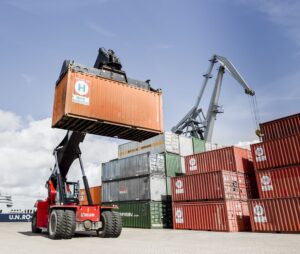 On November 2nd, the Federal Reserve Board (FRB) decided to raise interest rates by 0.75%, the fourth consecutive 0.75% rate hike since June, bringing the rate hike since the lifting of zero-interest rates in March to 3.75%. Not since 1981 has the rate risen this much in the same period. It is estimated that 80% of the world’s countries are affected by the strong dollar. Chair Powell seems to be aiming to avoid a recession and to make a soft landing on the high inflation with future rate hikes. Meanwhile, while the rest of the world is struggling with high prices, European central banks have also raised interest rates in response to rising U.S. interest rates, in order to counter inflation. Among these countries, only Japan is implementing “extraordinary monetary easing” and a “zero-interest rate policy”.
On November 2nd, the Federal Reserve Board (FRB) decided to raise interest rates by 0.75%, the fourth consecutive 0.75% rate hike since June, bringing the rate hike since the lifting of zero-interest rates in March to 3.75%. Not since 1981 has the rate risen this much in the same period. It is estimated that 80% of the world’s countries are affected by the strong dollar. Chair Powell seems to be aiming to avoid a recession and to make a soft landing on the high inflation with future rate hikes. Meanwhile, while the rest of the world is struggling with high prices, European central banks have also raised interest rates in response to rising U.S. interest rates, in order to counter inflation. Among these countries, only Japan is implementing “extraordinary monetary easing” and a “zero-interest rate policy”.
Reappointed in 2018, Bank of Japan Governor Kuroda’s five-year term will expire on April 8th next year. Kuroda’s bazooka gun has repeatedly missed its target, and despite being out of effective countermeasures, he has reiterated that he will not make any policy changes.
On October 20th, the yen on the Tokyo foreign exchange market hit $1.00=150 yen, the weakest level in 32 years since August 1990. About 32.2 million employees of small and medium-sized enterprises (SMEs), which account for 70% of all Japanese companies, are suffering from high prices due to the sharp rise in import prices.
I don’t think anyone expects that next year’s salaries will rise more than the current price level, at least under the three-year-long COVID-19 influence. According to the Ministry of Health, Labor, and Welfare’s wage index for fixed salaries, wages increased by only 2.8% in the past 20 years from 2001 to 2021, which is as low as 0.14% per annum. Of course, Japan has been indulging in low wages during the past 30 years of deflation, wearing out the legacy of its high-growth period and resulting in declining labor productivity and technological capabilities. Wage increases cannot be expected to exceed price increases. We cannot expect “to buy the yen in a crisis” anylonger.
According to Teikoku Databank, the number of domestic price increases as of the end of October was 6,699 items, and 833 items in November, totaling over 7,500 items. Furthermore, it is said that the number of items whose prices are scheduled to be raised next year will exceed 2,000. If the current depreciation of the yen continues, this rush of price hikes will continue. Half of these price hikes are said to be due to the weak yen. The Ministry of Finance has intervened several times to buy the yen, but has not been able to change the trend.
This reminds me of the “Asian Financial Crisis” that occurred in July 1997. It started with short selling of the Thai currency (baht) by institutional investors like U.S. hedge funds. Thailand, Indonesia, and South Korea were placed under the control of the IMF. Japan was no exception. In two days of October 7th and 8th, 1998, the yen appreciated 20 yen against the dollar, and in the same year, The Long-Term Credit Bank of Japan and The Nippon Credit Bank failed and were nationalized, The Hokkaido Takushoku Bank and Japan Leasing Corp. went bankrupt, and Yamaichi Securities voluntarily closed its business. The current yen crisis in Japan is like the Asian financial crisis in Thailand, Indonesia, and South Korea.
On October 28th, Prime Minister Kishida announced “Comprehensive Economic Measures to Overcome High Prices and Revive the Economy” and decided on fiscal spending of 39 trillion yen. Starting next year, the government will subsidize household electricity charges by 7 yen per kWh and city gas by 30 yen per cubic meter. For gasoline, the government intends to continue subsidies to petroleum wholesalers until the first half of next year, which will expire at the end of this year. 100,000 yen will be provided for newborn babies.
But this is not a fundamental solution. It appears to be nothing more than a futile struggle to win public favor. This is not a fundamental solution to the current weak yen and high prices. The zero-interest rate policy should be stopped as soon as possible, interest rates should be raised as in other countries, and the yen currency should be strengthened against the dollar to $1.00=120 yen or $1.00=110 yen. Otherwise, the public’s trust will not be gained.
This is because the “Nikkei Equilibrium Exchange Rate” estimated theoretically by the Nikkei and Japan Center for Economic Research for the period from April to June was $1.00 = 112.80 yen, while the actual exchange rate at that time was 129 yen. According to the Institute for International Monetary Affairs, the purchasing power parity of the yen based on the consumer price index (CPI) was calculated at $1.00=108 yen in September, and the actual exchange rate in September was at 140 yen, indicating that the yen was significantly weakening.
Unless the government makes a firm decision, we will not be able to fight off the hedge funds that are trying to make money by manipulating the exchange rate. I hope PM Kishida will seriously address the issue of the weak yen and take some immediate action!
On November 4th, the U.S. Department of Labor released its October employment report, which showed that the number of nonfarm payrolls exceeded market expectations, increasing by 261,000 from the previous month. The unemployment rate was 3.7%, up 0.2% from the previous month, but tighter labor supply and demand results in higher inflationary factors due to higher employment costs. As Elon Musk, who took control of Twitter, has taken steps to reduce the workforce by about 50% of all employees, the slowdown in the economy, particularly in the IT sector, has led to a noticeable reduction in the number of employees. Still, the fact that the unemployment rate has not risen above 4% means that there continues to be a shortage of workers in a wide range of areas in the U.S. labor market. Here we can see the strength of the U.S. economy.
 Spot freight rates from Asia to Europe and the U.S. continue to decline after China’s National Day in October, with rates to the West Coast of North America at $1,681 per FEU and to the East Coast of North America at $4,890 per FEU as of November 4th, the first time since April 2021 that rates to the East Coast of North America have fallen below $5,000 per FEU. Also, the freight rate for Northern Europe was $1,763 per TEU, the first time since November 2020 that it has fallen below $2,000 per TEU. The negative impact of China’s ongoing “Zero-COVID Policy” on economic activity and supply chains is immeasurable.
Spot freight rates from Asia to Europe and the U.S. continue to decline after China’s National Day in October, with rates to the West Coast of North America at $1,681 per FEU and to the East Coast of North America at $4,890 per FEU as of November 4th, the first time since April 2021 that rates to the East Coast of North America have fallen below $5,000 per FEU. Also, the freight rate for Northern Europe was $1,763 per TEU, the first time since November 2020 that it has fallen below $2,000 per TEU. The negative impact of China’s ongoing “Zero-COVID Policy” on economic activity and supply chains is immeasurable.
The problem of the large number of vessels waiting offshore in the U.S. ports has been cleared up, but the U.S. railroad labor-management negotiations remain unpredictable. There is a possibility of the U.S. railroad strike. If this occurs, the disruption of inland transportation can cause vessels to be held up in North American ports, so we must keep a close eye on the situation.
The U.S. midterm elections held on November 8th are said to favor the Republicans in both the Senate and the House of Representatives. If President Biden becomes a lame duck, the impact on the world, including the issue of Russia’s invasion of Ukraine, will not be small. I cannot help but be concerned that the world will become even more chaotic and unpredictable.
On October 31st, Ocean Network Express (ONE) announced its financial results for the April-September period of 2022. After-tax profit increased 63% year-on-year to $11.019 billion. Although container freight rates have been declining, profits were boosted by a sharp increase in annual contract rates in fiscal 2021. Although after-tax profit for the full year is expected to decline by 9% to $15.269 billion, full-year profit is expected to be 2.26 trillion yen due to the yen’s depreciation, exceeding 2 trillion yen for the second consecutive year. Meanwhile, on November 7th, industry newspapers simultaneously reported that Ocean Network Express (ONE) will pay a dividend of surplus to their respective parent companies. The total dividend amount is $5.506 billion (approximately 810 billion yen). The dividend is, $2.092 billion (approximately 31 billion yen) for NYK Line, while $1.707 billion (approximately 250 billion yen) for each of MOL and Kawasaki Kisen Kaisha. In addition, each of the three parent companies has significantly improved their capital adequacy ratios over the past year, with NYK at 62.0%, MOL at 51.8%, and Kawasaki Kisen Kaisha at 70.2% as of September 30th, 2022. Considering that their capital adequacy ratios were in the 20% range as of March 31st, 2021, I would say that ONE has contributed greatly to the improvement of the parent company’s structure, and I hope that ONE will continue to be a leader in the global container liner service.
 In front of an approximately 4.3 million TEU of excess containers in North America, shipping lines are beginning to off-hire their surplus units to leasing companies worldwide. Shipping lines themselves have been forced to lease-in more new containers in China than they needed because they were unable to evacuate empty containers from North America and Europe to China and Asia, where demand is higher, in a timely manner over the past three years due to supply chain disruptions caused by the COVID-19 pandemic. Another serious problem is whether the leasing companies have enough space in various locations to accept the off-hire of redundant containers from shipping lines.
In front of an approximately 4.3 million TEU of excess containers in North America, shipping lines are beginning to off-hire their surplus units to leasing companies worldwide. Shipping lines themselves have been forced to lease-in more new containers in China than they needed because they were unable to evacuate empty containers from North America and Europe to China and Asia, where demand is higher, in a timely manner over the past three years due to supply chain disruptions caused by the COVID-19 pandemic. Another serious problem is whether the leasing companies have enough space in various locations to accept the off-hire of redundant containers from shipping lines.
Newbuilt container production for October was 132,775 TEU (Dry: 122,207 TEU, Reefer: 10,568 TEU). Newbuilt prices at the end of October were $2,150 per 20f, down $200 (-8.5%) from last month. Compared to the end of this January, the price was $1,250 (-37%) lower. Newbuilt container factory inventory at the end of October was 1,046,585 TEU (Dry: 970,052 TEU, Reefer: 76,533 TEU). 178,775 TEU of newbuilt containers were delivered during October. Assuming that most of these containers were supplied to shipping lines, it appears at least the same number were returned to leasing companies’ depots in China. It seems there is already a depot space shortage problem in Shanghai and Busan, and Japan is no exception. Under the circumstances that shipping lines are evacuating surplus containers in China and Asia to Japan as a temporary shelter, it is undeniable that container inventories are piling up. Leasing companies are struggling to secure depot space in Kobe and Yokohama.
(Translated by Ms. Chizuru Oowada)